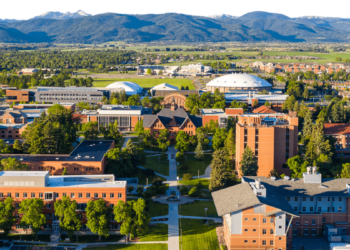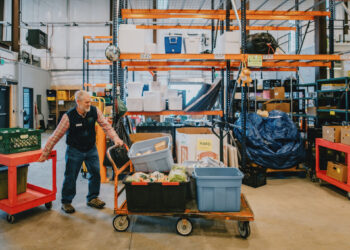CENTER FOR LARGE LANDSCAPE CONSERVATION
This article is the second in a planned three-part series on wildlife-vehicle conflict. Here’s part one and part three.
In the late 1920s, many tourists eager to see the wildlife and geothermal wonders of Yellowstone National Park traveled via the railway known as the “Milwaukee Road.” In Three Forks, Montana, the passengers transferred to electric trains to reach the Gallatin Gateway Inn, where buses awaited them for the final leg of their journey to the park along U.S. Highway 191.
The bison, bears, deer and other native wildlife that moved in and out of the northwest portion of Yellowstone National Park, core habitat within the Greater Yellowstone Ecosystem, likely took little notice of the intermittent passers-by on the still-unpaved highway snaking along the Gallatin River.
Over the past century, the patchwork of public and private lands along the highway has become more human dominated. Today residents, visitors and commuters rely on U.S. 191 for access to jobs, education, medical care and recreation, with the highway also serving as a major trucking route. Now, the same road that is so important for connecting human communities is dividing wildlife habitat.
With its increasing traffic, U.S. 191 cuts right through prime habitat for resident, migrating and wide-ranging animals along the Gallatin River’s riparian corridor and adjacent lands. This has led to more wildlife vehicle collisions, and road-killed animals of all sizes are a frequent sight for drivers. But a more insidious effect of the road is the physical barrier it can create to the daily and seasonal wildlife movement necessary for survival.
The barrier effect
The “barrier effect” refers to the obstruction that linear infrastructure, like roads or railways, can pose to the movement of animals. Researchers who measure the effect of roads on wildlife movement identify three main levels of traffic.
“At light traffic levels, animals can cross relatively safely and rarely become roadkill. At medium traffic volumes, they try to cross but get hit a lot—but also succeed a lot—or they wouldn’t keep trying,” said Rob Ament, senior conservationist at the Bozeman-based Center for Large Landscape Conservation. “At high traffic volumes, either they can’t get across safely or the noise, fumes, headlights, and other artificial stimuli stop them from even trying. Thus, a road becomes a complete or nearly complete barrier for wildlife movement.”
Many species are sensitive to traffic and lose road crossing opportunities as levels increase. A study of collared grizzly bears along U.S. Highway 2 just south of Glacier National Park showed that when traffic hit 100 vehicles per hour, bears never crossed the highway. The only window of time when traffic was lower, the study found, was from late at night to just before sunrise. This study shows how traffic levels can create a complete (in the daytime) or a partial barrier (at night) for wildlife movement.
In addition to the risk of an individual bear being hit by a vehicle, a busy road may have longer-term ramifications for an entire regional grizzly population. During mating season grizzlies roam vast distances to promote their availability as mates. If journeys are sidetracked by roads or other development, the loss of habitat connectivity can reduce the genetic diversity critical to population health.
Reproduction and gene flow aren’t the only natural processes stymied by road barriers. Each spring, thousands of elk in six to eight herds migrate from lower elevation winter ranges, including in the Custer Gallatin National Forest and surrounding private land, to higher-elevation summer ranges in and around Yellowstone National Park.
“Elk, having no regard for lines on a map, rely not only on protected areas but the areas in between,” Ament said. “We know from elk collar data that these herds use the same migration corridors year after year. We don’t want busy roads or new subdivisions blocking age-old routes.”
Disrupted migration patterns can mean less access to high-quality forage when food supply may be affected by deep snow, drought or fires.
In addition to terrestrial species, roads can even pose a barrier for fish. When a road is built over a river or stream, culverts are placed to allow water to flow underneath. However, not all culverts are adequately sized or positioned for fish passage or for other aquatic and semi-aquatic species, such as frogs and mink. Designing culverts to improve fish passage and upsizing them to protect roads during severe weather events can also benefit wildlife. Weasels, coyotes, bobcats, and other small and medium sized mammals can take advantage of dry areas within large culverts.
Ament says that he and fellow professionals in the field of road ecology urge avoidance of core habitat as a best option, whenever possible. Routing a road so it doesn’t impact the most critical habitat or migration routes is the first step in the “mitigation hierarchy,” the ecologists’ golden rule for addressing impacts of roads on biodiversity.
But there is no going back to the 1920s, when herds of elk and other wildlife shared U.S. 191 with an occasional bus of Yellowstone-bound tourists.
“Once a busy road already exists, the focus can only be on mitigation measures,” said Ament, who co-authored the U.S. 191/MT-64 Wildlife & Transportation Assessment. “The most effective solutions are wildlife overpasses or underpasses, accompanied by fencing, which stitch back together landscapes that have been severed.”
Wildlife crossings are a win-win,” Ament added. “They conserve wildlife habitat, overcome the barrier effect, and make roads safer for all of us.”
Individuals interested in the findings of the US-191/MT-64 Wildlife & Transportation Assessment and updates on the topic can learn more at largelandscapes.org/191













